Two species of flycatchers will occasionally nest in a bluebird nestbox: The Great Crested Flycatcher (GCFL, Myiarchus crinitus) and the Ash-Throated Flycatcher (ATFL, Myiarchus cinerascens).
The GCFL is found east of the Rockies, and has a bushy crest, large bill, dark olive back, and a bright yellow belly and undertail. It is about 7-9″ long, and is the only eastern flycatcher that nests in cavities.
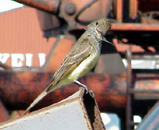
The ATFL lives in the Southwest, usually in hot, dry areas with cactus, and in dry, open woodlands from Colorado to Washington. They may also be found in forested mountain areas where there is no cactus. The ATFL is smaller (8″)and less colorful, but is also a dull olive color. Birder Tina Mitchell describes them thus: “Bart Simpson” feathers on the crown, the gorgeous shadings of brown outlining the secondary coverts (the feathers that create the appearance of wing bars) on the wings, and a richly rufous tail. (Note: click on smaller photos for larger version. Thanks to S. and K. Kridler, L. Violett, J. Garriott, and H. Priest and T. Levy for use of photos.)
Both European Starlings and House Sparrows compete with flycatchers for nesting cavities.
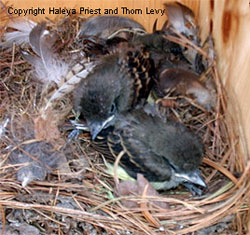
GREAT CRESTED FLYCATCHER (GCFL)
The GCFL usually nests in clearings and edges of mature forest, orchards, parks, swamps, and cultivated areas scattered with trees. Like bluebirds, these flycatchers are secondary cavity nesters, meaning they rely on cavities created by other creatures. They usually build their nests high up in trees (3-70 feet off the ground), but will occasionally nest in gutters, pipes and tin cans.
Nest and Egg ID: Their bulky nest is constructed of small twigs, leaf litter, pine needles, bark fibers, poplar/cottonwood seeds, moss, lichen, grass, and rootlets, hair (from dogs, cats, cattle, pigs, rabbits, and horses), feathers, string, seed pods, cloth and paper, pieces of onion skin, paraffined or oiled paper, bits of eggshell, pieces of horse manure. The nest is usually about 10-18″ high(most are 12-15″).Off to one side (often in the back), the cup is lined with finer hair, feathers or fur. About 75% of nests may contain a small piece of shed snakeskin or cellophane. See photo album.
The eggs are 23×17 mm (larger than a HOSP egg),moderately glossy, ivory/cream/pink, and densely streaked/scrawled with fine purple, gray, red, brown, or olive markings often concentrated on the larger end of the egg.
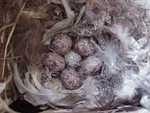
Monitoring: May abandon box if wasps build a nest. If an egg is lost, may re-nest in same box. May be difficult to see or count eggs without a mirror as nest cup is usually in back corner of box.
GCFL Nesting Timetable:
- Mid-March to mid-June: nesting begins (depending on latitude).One brood per season. Tend to nest at the same site every year. May nest after starlings and woodpeckers.
- Nest building: about 2-14 days, mainly by the female.
- Egg laying: usually within 10 days of arrival. 4-6 eggs (usually5). Feathers may be added during egg laying/incubation. Does not hang around nest while in between laying eggs.
- Hatching: Eggs usually hatch over a 1-2 day period.
- Incubation: 13-15 days, when the next to last egg is laid (Richard Harlow reported incubation beginning after 4th egg in 6 egg clutch was laid). Early on parents consume fecal sac, remove sacs until fledgling.
- Fledging: 12? or 14-21 days (13-15 may be typical) after hatching. May stay in the nest longer when food is limited. After fledging, they do not stay in the area for more than 3-4 days.
GCFL populations are impacted by competition from starlings and flickers for breeding sites. GCFLs prefer to nest in natural cavities in dead trees, but may use abandoned woodpecker holes and may use a nestbox designed for flickers, or kestrels (with a 3″ entrance hole). They may also use a regular bluebird box if the hole has been widened by woodpeckers, squirrels, etc. Robert Wilson reported GCFLs building nests on top of bluebird nests (in some cases on top of live young). He used paired boxes (15-20 feet away) to prevent this.
Nestboxes for flycatchers share many features of a good bluebird nestbox, such as:
- constructed of 1″ thick wood to provide insulation in summer and winter
- not painted or stained
- ventilation holes at the top on the sides
- four bottom corner holes in the floor for drainage
- slanted roof for water drainage that extends over the entrance hole
- A floor that is slightly recessed to keep it dry
- A latched door that opens for cleaning
- a rough sawn door that provides a foothold for fledglings when they are ready to leave the nest
- in pine trees, mixed conifer, or hardwood stands.
- mounted on metal conduit with a predator guard.
- Occasionally use large plastic Purple Martin gourds.
The following differences from a standard bluebird box are recommended based on the experience of folks on the Bluebird Listserv:
- An entrance hole that is at least 1 3/4″ in diameter. GCFLs may prefer a 2 1/2-3″ diameter entrance hole. A 1 9/16″ hole will prevent starlings (a major competitor) from entering. A Peterson oval entrance hole (1.375″ x 2.250″ oval hole) will also work. (Note: 1 5/8″ is thought to be too small, but Phil Berry in Florida has had a number of GCFLs nest in boxes with 1.5″ holes.)
- Entrance hole 7- 8″ off the floor. (Note: However, GCFLs will nest in a purple martin house that has the entrance hole 1″ off the floor)
- 12-18″ deep (16″ is good) to prevent predators from reaching in to nab eggs or nestlings. 50Birds plan is 9″ deep.
- 4-7″ square floor (6-7″ may be preferred). Sometimes GCFL’s will use a much smaller box however – including a Gilbertson.
- Nestbox placed on a tree or post near an open area, between 6-24 feet off the ground (boxes 15-20 feet high may be preferred) in open areas, near (about100 feet away?) woodlands
- May prefer boxes that hang/swing from about40″ of chain or flexible wire (which starlings will generally avoid.)
- Avoid frequent monitoring – the female may hiss and strike at you (snake-like) when the nestbox is opened during incubation.
Behavior and Diet: GCFLs tend to be secretive, darting in to feed the babies quickly and quietly, although they do make a loud, squawking “whreep” or “phrre-e-e-e-e-e-ep” call. Newly fledged flycatchers cling to trees like woodpeckers.
GCFLs eat more than 50 kinds of beetles, along with wasps, bees, sawflies, stable flies, mosquitoes, grasshoppers, crickets, katydids, moths, caterpillars, cicadas and other insects; and berries such as mulberries, pokeberries, blackberries, and wild grapes.
ASH-THROATED FLYCATCHER (ATFL)
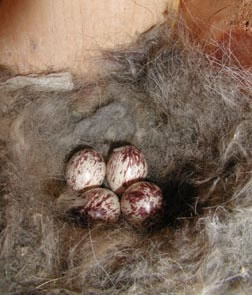
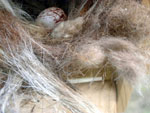
The ATFL may use a nestbox with a 5×5 floor and a 1.5″ or oval hole mounted or hanging in pastures or clearances, near sagebrush/chaparral/mesquite, pine, cedar, near heavily wooded or open forested areas, and perhaps a creek or a pond. The 50 Birds nestbox plan is the same as one for a GCFL.
They may nest lower than GCFLs: 3-20 feet (commonly 7 to 15 feet) off the ground, in floral stems of yucca or agave plants and even in metal fence posts, drainpipes, tin cans, and mailboxes. They are also secretive. May “explode” out of the nestbox when monitors approach.
Nest and Egg ID: They typically use rootlets, grass, weed stems, and dry cow or horse dung in the nests, and line the cup with fine grass and matted hair/fur. Unlike the GCFL, they seldom add snakeskin to their nests.
Eggs are oval, smooth, slightly glossy ,creamy white to ivory, and sometimes pinkish white background color, marked with fine or heavy streaks or blotches in browns, purples, and grays (fewer markings than GCFL eggs.)
Monitoring: A bander reported that ATFL females should not be handled for banding purposes during incubation, or there is about a 50% chance that they will abandon their clutch of eggs. (Steve Simmons)
ATFL Nesting Timetable:
- March-May: nesting begins (depending on latitude).One brood per season.
- Nest building: about ?? days, primarily by female?
- Egg laying: usually within ?? days of arrival. Typically 4-5eggs, may lay 3-7.
- Incubation: 13-15 days. During hot weather, female may leave nestfor hours at a time.
- Fledging: 13-17 days after hatching. After fledging,they remain dependent on parents for food/protection for another2-3 weeks.
FOR MORE INFORMATION:
- Great Crested Flycatcher photos – nests, eggs, young, adult
- Great Crested Flycatcher: CornellBirdhouse Network bio, ChipperWoods Bird Observatory
- Ash-Throated Flycatcher: Cornell Birdhouse Networkbio
- BluebirdListserv postings on flycatchers
- Nest and egg ID (this website)
- GFCL – Florida Breeding Bird Atlas
- Nestbox plans: ATFL and GCFL from 50 Birds
- GCFL – good photos of bird, and list of plants to attract
- Patuxent USGS – photos, ID tips, song, etc. for GCFL and ATFL
- Video of Flycatcher building nest (outside nestbox)
Photos by Shawn and Keith Kridler, J. Garriott, Haleya Priest and Tom Levy, Ash-Throated Flycatcher eggs by Linda Violett.
Thus the goat-suckers, the swallows, the tyrant fly-catchers, and the jacamars, all use the same kind of food, and procure it in the same manner: they all capture insects on the wing, yet how entirely different is the structure and the whole appearance of these birds!
– Source?
